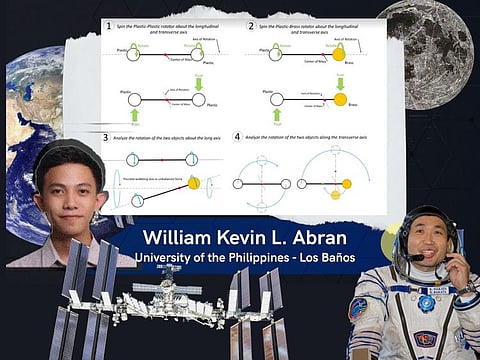Filipino experiment at International Space Station: What you need to know
Proposed experiment could have far-reaching implications in space science

A Filipino student’s rather simple proposal for a space-age experiment will be conducted at the International Space Station (ISS).
The trial would explore the long-term stability of dumbbell-shaped objects’ rotations in a “free” environment, or microgravity, which could have far-reaching implications in space science, the Philippine Space Agency (PhilSA) announced earlier this week.
William Kevin L. Abran, a junior applied physics major at the University of the Philippines Los Baños has proposed the experiment, which he called “Rotation of ‘Dumbbell-shaped’ Objects in Space.”
Spinning rotators
According to Abran’s proposal, a rigid object — like “dumbbell-shaped rotators” — could be spun about in both longitudinal axis and along the transverse axis.
Since it only has two distinct principal moments of inertia, a rotation along the principal axes is hypothesised to be stable — and will not result in the “Dzhanibekov” effect.
On the ground, where gravitation forces are strong, it is difficult to simulate these motions — without pre-determining the centre of mass or without the constant application of force.
“However, in a free environment, like in microgravity, rigid objects could rotate continuously for a fair amount of time, so it will be possible to observe the long-term stability of their rotations,” Abran’s proposal reads.
How the ISS experiment idea was picked
His proposal is one of the six experiments picked to be performed in the ISS, following a selection process under the Asian Try Zero-G (ATZG) 2022 competition.
It was among the 24 finalists of the international competition this year — which received a total of 201 submissions from 480 students, young engineers and researchers.
Evaluation
Proposals were evaluated based on scientific significance, novelty, safety, resource requirement, and feasibility.
PhilSA organised the local call for proposals for this year’s ATZG Philippines. For the preliminary round, PhilSA accepted and screened proposals from May 9 to 29 and selected five experiments, including Abran’s, to enter the final round of evaluation by JAXA (Japan Aerospace Exploration Agency) experts and astronauts.
ATZG is one of the activities of the Kibo-ABC program that aims to expand the use of the Kibo module on ISS and develop the youth’s understanding of space environments.
Significance
Japan Aerospace Exploration Agency (JAXA) astronaut and engineer Koichi Wakata will conduct the experiments later this year.
Given that the dumbbell-shaped object only has two main moments of inertia, if the dumbbell shape proves to be stable, it could potentially be applied when designing spacecraft and other materials.
“I designed the experiment to be unique but simple because time and resources in the space station are very limited. It was the simplest among the final topics. That’s why I was surprised that JAXA still considered it,” Abran told PhilSA.
“Still, I’m very honoured and excited for this new learning opportunity. I’m thankful to the Philippine Space Agency for supporting my proposal and helping me improve the design of the experiment,” he says. “I hope this event sparks the interest of other students in space science.”
“Dzhanibekov Effect”
The "Dzhanibekov Effect” is named after Russian cosmonaut Vladimir Dzhanibekov, who discovered the phenomenon when he was in space in 1985. The effect is described in standard mechanics as the movement of a rigid object with three main axes of rotation — in effect, three different ways in which you spin/rotate the object, or with the help of three distinctive key “moments of inertia”. It is best demonstrated a tennis racket is tossed in the air (also know as the “Tennis Racquet Theorem”), where the object will be “stable” only near Axes 1 and Axes 3 — but will be unstable about the Axis 2, also known as the “intermediate axis”. The odd-looking effect takes place when the body is rotated about an axis which is near the intermediate axis. Since Abran’s proposal only has two distinct principal moments of inertia, a rotation along the principal axes is hypothesised to be stable.
Sign up for the Daily Briefing
Get the latest news and updates straight to your inbox






